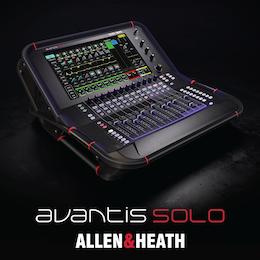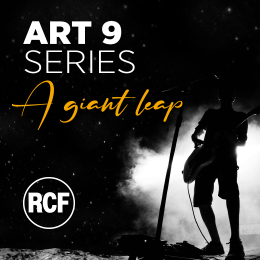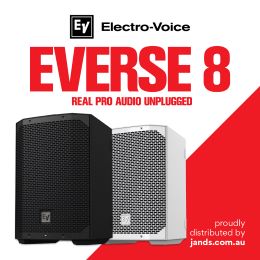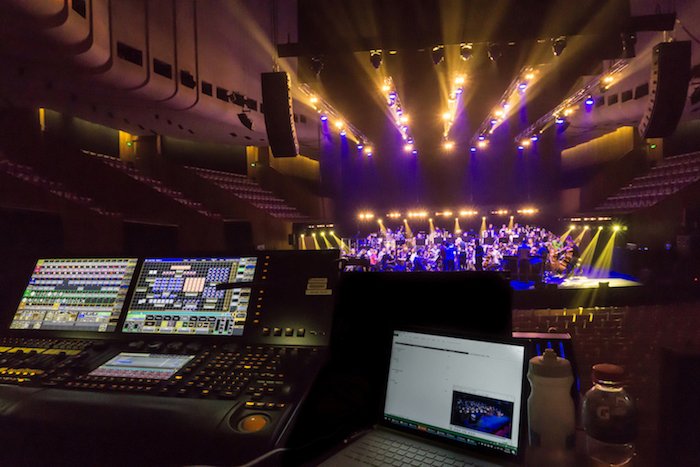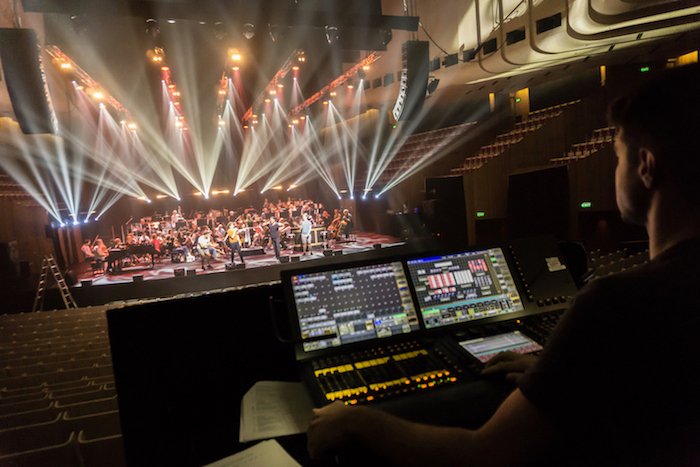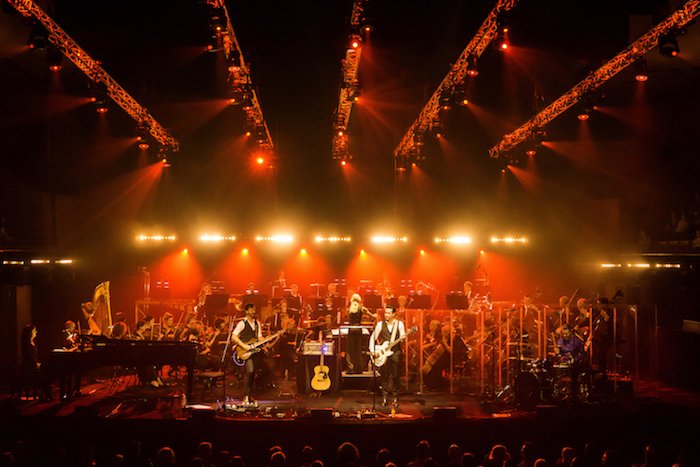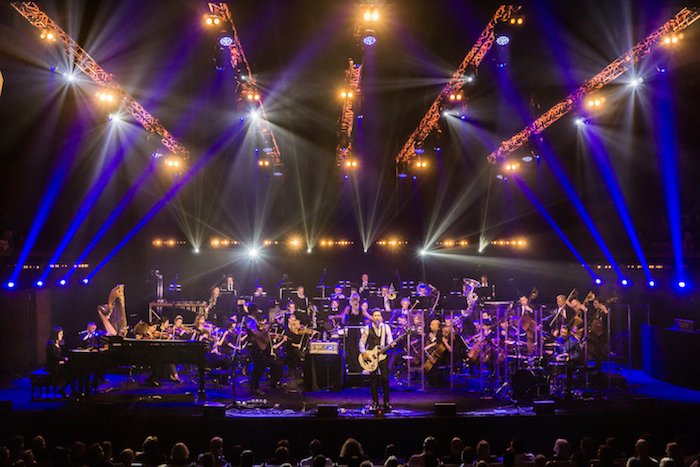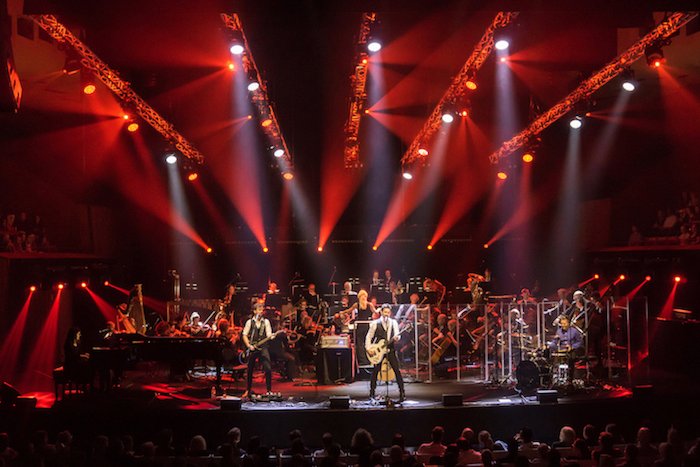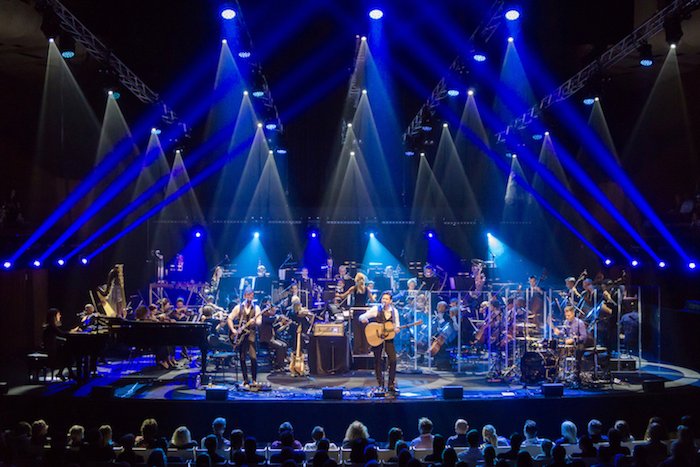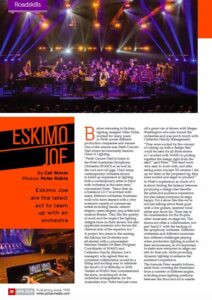Subscribe to CX E-News
ROADSKILLS
Eskimo Joe
By Cat Strom
Photos: Peter Rubie
Eskimo Joe are the latest act to team up with an orchestra.
Before relocating to Sydney, lighting designer Peter Rubie worked for many years in Perth across different production companies and venues. One of the venues was Perth Concert Hall where he eventually became Head of Lighting. “Perth Concert Hall is home to the West Australian Symphony Orchestra (WASO) so as well as the rock and roll gigs, I had many contemporary orchestra shows to build up experience in lighting both a contemporary artist or band with orchestra at the same time,” commented Peter.
“Since then as a freelance LD I’ve worked with many different orchestras Australia-wide who have teamed with a very extensive variety of commercial artists including bands, cabaret singers, opera singers, pop artists and musical theatre.
“They like the quality of work and the impact the lighting designs have on their shows, but also appreciate someone who knows the classical side of the equation too.” A project two years in the making, the Eskimo Joe Orchestra tour all started with a conversation between Natalie De Biasi (Program Coordinator at WASO) and Catherine Haridy (Eskimo Joe’s manager), who agreed that an orchestral collaboration would be a fitting and exciting way to celebrate the band’s 21’st Birthday in 2018.
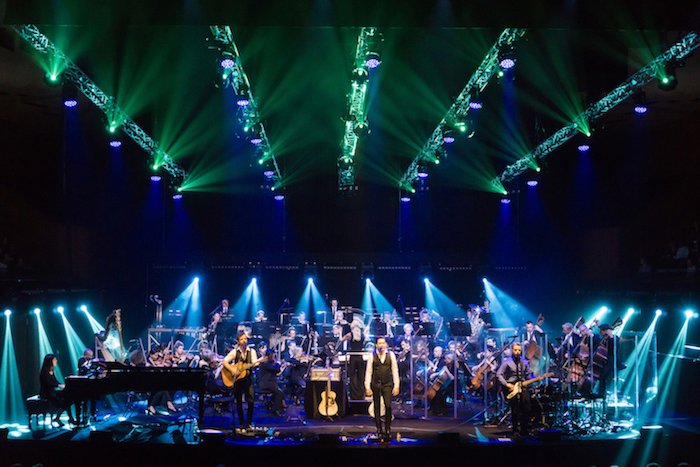
Natalie at WASO then commissioned the show, including all of the orchestral arrangements, for the Australian tour. Peter had just come off a great run of shows with Megan Washington who also toured the orchestras and was put in touch with Catherine Haridy Management.
“They were excited by the concept of coming up with a design that could be used for all three shows so I worked with WASO in putting together the design right from the start,” said Peter. “The band were very easy to work with, and after seeing some concept 3D renders I did up for them of the proposed rig, they were excited and eager to proceed.”

In Peter’s experience, so much of it is about finding the balance between producing a design that benefits the artist and audience experience but also keeps everyone on stage happy. For a show like this we’re not just talking about three guys with a few guitars, talented vocal styles and drum kit. There has to be consideration for the 50-plus other musicians on stage too.
The shows are often a collaboration, not just ‘band X’ with the backing of the symphony orchestra. Different orchestras and different musicians face different challenges playing when production lighting is added to their environment, so it’s important to make sure everyone on stage can still do their job, while providing dynamic lighting to enhance the audience’s experience.
 The formula Peter usually follows, aside from covering the musicians from a number of different angles, is finding some lighting positions between the floor and air to enable him to fill out midair space with colour and beams or texture. With an orchestra, it’s a big stage setup with a lot of musicians, so it’s important that the space also feels full, otherwise everyone gets lost in the large concert hall spaces.
The formula Peter usually follows, aside from covering the musicians from a number of different angles, is finding some lighting positions between the floor and air to enable him to fill out midair space with colour and beams or texture. With an orchestra, it’s a big stage setup with a lot of musicians, so it’s important that the space also feels full, otherwise everyone gets lost in the large concert hall spaces.
“For this show it was important to produce a design that felt very rock and roll but also felt full and encompassed the whole stage, so that the orchestra were as much as part of the show as the band,” explained Peter.
“I worked closely on the design with Alex Spartalis from CCP who provided us a fantastic rig for the Perth show. Alex also works regularly with WASO so having that collaboration was invaluable.”
The end result of many discussions was a set of five raked truss fingers that reached out from upstage to downstage giving a canopy of available lighting effects over the whole stage. Some more fixtures were arranged just above head height to fill the aerial space with texture and beams and had the option of kicking back down into the stage for more intimate moments.
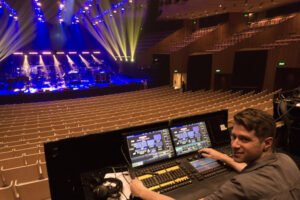 The Perth leg had some different fixtures, but for the concert with the Sydney Symphony Orchestra, Peter had twenty Martin MAC Quantum Profiles overhead and nineteen Robe Spiiders. The truss fingers were also complemented with ShowPro Trussmates and a smattering of Duet Blinders. Rigging trusses in this configuration at the Sydney Opera House comes with a few weight restrictions so fixture weight was a big factor.
The Perth leg had some different fixtures, but for the concert with the Sydney Symphony Orchestra, Peter had twenty Martin MAC Quantum Profiles overhead and nineteen Robe Spiiders. The truss fingers were also complemented with ShowPro Trussmates and a smattering of Duet Blinders. Rigging trusses in this configuration at the Sydney Opera House comes with a few weight restrictions so fixture weight was a big factor.
“At only 23 and 13kg for the Quantum and Spiider respectively, they were perfect for this job,” Peter said. “Although I would have preferred a brighter profile, the Quantum is a good little workhorse and I’m always impressed by its crisp projection and flat field. Being LED I also don’t need to worry about them all being different brightness of lamp life in a symmetrical rig of twenty units which is a relief.
“The Spiider from Robe is my current favourite LED wash light. The flower effect feature is very cool to reveal a couple of times in the show, but tricks aside, as a wash light it outputs a beautiful quality of light with some lovely colours. There are a few other similar lights in its category which try to do brightness over quality.
“I find they are often too bright and the head produces far too much glare for most looks anyway, so I’d rather a wash fixture that is just bright enough but delivers a better quality of light without needing an aftermarket louver accessory to reduce the glare.”
Just above head-height, wrapping around the stage, were an additional six MAC Quantum Profiles and eight Claypaky Sharpys for that rock and roll beam look. Between each of these units was a Sunstrip which, along with the Duets above, provided that all important tungsten element which you just can’t truly emulate with LED fixtures.
FOH lighting the orchestra and the band were seven MAC Viper Performance and a bunch of MAC 101 CTs which, according to Peter, make for excellent moving band specials when you can’t send someone up there with a harness.
“Fixture choice wasn’t as big a problem for this particular orchestra collaboration as Eskimo Joe are quite rock and roll but normally I’m chasing silent fixtures,” added Peter.
“I’m pleased to see this is finally starting to become a focus from manufacturers and there have been some good options released in the last year for fixtures that are bright enough for shows this size but quiet enough to be used in noise-challenging environments with classical musicians.
“These shows are often put on in concert and recital halls that have been acoustically designed to naturally amplify a stage of classical instruments. Unfortunately they often amplify fan noise too, so I’m looking forward to seeing larger quantities of these type of units available at the local suppliers over the coming year.”
Peter used an MA Lighting grandMA2 light at FOH as both PCH and SOH have these in-house so it made sense for consistency’s sake. The show has more life in it yet and is next headed to Hobart with TSO. For this show Peter will tour his MA command wing setup.
This article first appeared in the print edition of CX Magazine April 2018, pp.38-39. CX Magazine is Australia and New Zealand’s only publication dedicated to entertainment technology news and issues. Read all editions for free or search our archive www.cxnetwork.com.au
Photos: Peter Ruble. All text and photos © CX Media
Further reading: 20 Questions – James ‘Oysters’ Kilpatrick FOH sound engineer (2016)
Subscribe
Published monthly since 1991, our famous AV industry magazine is free for download or pay for print. Subscribers also receive CX News, our free weekly email with the latest industry news and jobs.


